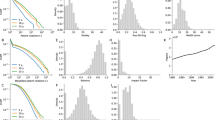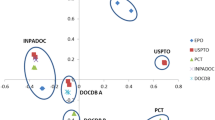Abstract
We analyze the distributions of paper–paper and paper-patent citations and estimate the relationship between them, based on a 4763-paper sample among the top 100 researchers in the life and medical sciences fields in Japan. We find that paper–paper citations peak at a 4-year average, while the corresponding lag for paper-patent citations is 6 years. Moreover, we show that paper quality is important for being cited by a patent. An inverse U-shaped relationship exists between the research grant and research quality, whereas a U-shaped relationship exists between research quality and total number of papers.


Similar content being viewed by others
Notes
They use the NPRs cited on the front pages of US patents.
Thompson (2006) plots the distribution of cited patent ages using patent–patent citations and the backward citation approach. He shows that the age of examiner citations is younger than that of inventor citations.
Since recently published papers have only had the opportunity to be cited for a few years, it is necessary to note that citations of these papers may not have yet peaked. However, because the median lag for paper-patent citations is 5 years, papers published during 05–07 are highly likely to have already peaked. We test another two subperiods (each year and three subperiods) by way of a robustness check and find the same tendency, namely that the median lag for paper-patent citations lag has shortened in recent years.
Since only the linear prediction of marginal effects is available for the two-step estimation, the marginal effect is estimated by using the maximum likelihood estimator. Because the coefficient of the quadratic term of paper-paper citations is not statistically significant, we thus calculate the marginal effect by using Model 1.
References
Anderson, J., Williams, N., Seemungal, D., Narin, F., & Olivastro, D. (1996). Human genetic technology: Exploring the links between science and innovation. Technology Analysis & Strategic Management, 8(2), 135–156.
Bouabid, H., & Lariviére, V. (2013). The lengthening of paper’s life expectancy: A diachronous analysis. Scientometrics, 97(3), 695–717.
Callaert, U., Pellens, M., & Van Looy, B. (2014). Source of inspiration? Making sense of Scientific references in patents. Scientometrics, 98(3), 1617–1629.
Finardi, U. (2011). Time relations between scientific production and patenting knowledge: The case of nanotechnologies. Scientometrics, 89(1), 37–50.
Finardi, U. (2014). On the time evolution of received citations, in different scientific fields: An empirical study. Journal of Informetrics, 8(1), 13–24.
Glänzel, W. (2004). Towards a model for diachronous and synchronous citation analysis. Scientometrics, 60(3), 511–522.
Guan, J., & He, Y. (2007). Patent-bibliometric analysis on the Chinese science-technology linkages. Scientometrics, 72(3), 403–425.
Harhoff, D., Narin, F., Scherer, F., & Vopel, K. (1999). Citation frequency and the value of patented inventions. The Review of Economics and Statistics, 81(3), 511–515.
Hicks, D., Breitzman, A., Kimberly, S., & Narin, F. (2000). Research excellence and patented innovation. Science and Public Policy, 27(5), 310–320.
Ida, T., & Fukuzawa, N. (2013). Effects of large-scale research funding programs: A Japanese case study. Scientometrics, 94(2), 1253–1273.
Jong, S., & Slavova, K. (2014). When publications lead to products: The open science conundrum in new product development. Research Policy, 43(4), 645–654.
Lo, Azu-chia. (2010). Scientific linkage of science research and technology development: A case of genetic engineering research. Scientometrics, 82(1), 109–120.
Mansfield, E. (1991). Academic research and industrial innovation. Research Policy, 20(1), 1–12.
Mansfield, E. (1995). Academic research underlying industrial innovations: Sources, characteristics, and financing author(s). The Review of Economics and Statistics, 77(1), 55–65.
Mattsson, P., Sundberg, C., & Laget, P. (2011). Is correspondence reflected in the author position? A bibliometric study of the relation between corresponding author and byline position. Scientometrics, 87(1), 99–105.
McMillan, G., Narin, F., & Deeds, D. (2000). An analysis of the critical role of public science in innovation: The case of biotechnology. Research Policy, 29(1), 1–8.
Meyer, M. (2000). Does science push technology Patents citing scientific literature? Research Policy, 29(3), 409–434.
Narin, F., Hamilton, K., & Olivastro, D. (1997). The increasing linkage between US technology and public science. Research Policy, 26(3), 317–330.
Narin, F., & Olivastro, D. (1998). Linkage between patents and papers: An interim EPO/US comparison. Scientometrics, 41(1–2), 51–59.
Newey, W. (1987). Efficient estimation of limited dependent variable models with endogenous explanatory variables. Journal of Econometrics, 36(3), 231–250.
Rassenfosse, G. (2013). Do firms face a trade-off between the quantity and the quality of their inventions? Research Policy, 42(5), 1072–1079.
Sanberg, P., Gharib, M., Harker, P., Kaler, E., Marchase, R., Sands, T., et al. (2014). Changing the academic culture: Valuing patents and commercialization toward tenure and career advancement. Proceedings of the National Academy of Sciences of the United States of America, 111(18), 6542–6547.
Thompson, P. (2006). Patent citations and the geography of knowledge spillovers: Evidence from inventor- and examiner-added citations. The Review of Economics and Statistics, 88(2), 383–388.
Tijssen, R., Buter, R., & Van Leeuwen, Th. (2000). Technological relevance of science: An assessment of citation linkages between patents and research papers. Scientometrics, 47(2), 389–412.
Van Vianen, B., Moed, H., & Van Raan, A. (1990). An exploration of the science base of recent technology. Research Policy, 19(1), 61–81.
Verbeek, A., Debackere, K., Marc, L., Andries, P., Zimmermann, E., & Deleus, F. (2002). Linking science to technology: Using bibliographic references in patents to build linkage schemes. Scientometrics, 54(2), 399–420.
Wren, J., Kozak, K., Johnson, K., Deakyne, S., Schilling, L., & Dellavalle, R. (2007). A survey of perceived contributions to papers based on byline position and number of authors. EMBO Reports, 8(11), 988–991.
Zucker, L., & Darby, M. (2001). Capturing technological opportunity via Japan’s star scientists: Evidence from Japanese firm’s biotech patents and products. Journal of Technology Transfer, 26(1–2), 37–58.
Acknowledgments
Thanks are due to Elsevier Japan for its assistance. This work was supported by JSPS KAKENHI Grant Number 25590074.
Author information
Authors and Affiliations
Corresponding author
Rights and permissions
About this article
Cite this article
Fukuzawa, N., Ida, T. Science linkages between scientific articles and patents for leading scientists in the life and medical sciences field: the case of Japan. Scientometrics 106, 629–644 (2016). https://doi.org/10.1007/s11192-015-1795-z
Received:
Published:
Issue Date:
DOI: https://doi.org/10.1007/s11192-015-1795-z




